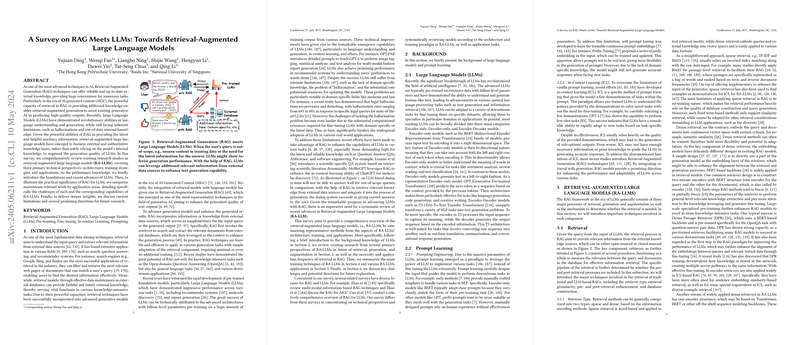Exploring the Synergy of Retrieval-Augmented LLMs (RA-LLMs)
Introduction to RA-LLMs
Retrieval-Augmented Generation (RAG) has become a significant technique in enhancing the capabilities of LLMs. By integrating external data retrieval into the generation process, RA-LLMs effectively address the limitations commonly associated with LLMs, such as outdated knowledge bases and the propensity for generating incorrect or hallucinated information. This approach not only updates the model's knowledge base dynamically but also enriches the content generation quality by drawing from external, authoritative sources.
Key Components of RA-LLMs
RA-LLMs consist of three primary components: the retrieval system, the generation model, and the integration mechanism that combines retrieval with generation. Understanding these components helps in appreciating how RA-LLMs refine the data processing and output generation:
- Retrieval System: This subsystem is responsible for fetching relevant information from external databases or the internet, depending on the query's needs. It can be based on either sparse or dense retrieval techniques, each with its benefits and suitable applications.
- Generation Model: Typically a pre-trained LLM that, when augmented with retrieved information, generates responses or content. This model can either be fine-tuned further or used in a zero-shot/few-shot manner depending on the availability of training data and the specific application requirements.
- Integration Mechanism: This refers to how the retrieved information is incorporated into the generation model. This can be done before the generation process (pre-processing), during (in-line), or after the generation (post-processing). The choice of integration significantly impacts the coherence and relevance of the generated content.
Applications and Impact
Mostly utilized in NLP, RA-LLMs are making a profound impact across various domains:
- Question Answering Systems: By accessing the latest information from external sources, RA-LLMs can provide more accurate and contextually relevant answers.
- Content Creation: In media and journalism, RA-LLMs assist in creating content that is not only up-to-date but also factually accurate, by pulling information from verified external databases.
- Educational Tools: In educational technology, RA-LLMs can provide explanations, supplementary information, and learning resources that are tailor-made to student queries by retrieving data from diverse educational materials.
Emerging Trends and Future Directions
The development of RA-LLMs is continuously evolving, and several trends are likely to shape their future:
- Multi-modal Retrieval: Incorporating images, videos, and other non-textual data into the retrieval process to enrich the generation capabilities of LLMs, making them more versatile in handling various data formats.
- Cross-lingual Knowledge Utilization: Enhancing RA-LLMs to effectively retrieve and utilize knowledge across different languages, thereby making AI applications more globally accessible and useful.
- Ethical and Responsible Use: Ensuring that the use of RA-LLMs adheres to ethical guidelines and contributes positively to societal needs without bias or misrepresentation of information.
Conclusion
In summary, Retrieval-Augmented LLMs represent a significant advancement in making AI models more robust, versatile, and aligned with real-world knowledge needs. As these models continue to evolve, they are likely to address more complex challenges across various sectors, paving the way for more intelligent and context-aware AI systems.
